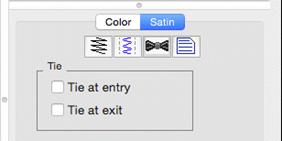
Ties are stitches that form knots in the embroidery both allowing for trims and to pull up the bobbin thread when stitching has just begun. We refer to these as entry ties and exit ties, but some may call describe it as “tying in” and “tying out.”
In each object property page you are given the opportunity to explicitly set ties. Click the button with the bow tie icon on it.

The ties are computed automatically to use the direction of stitching to find an innocuous angle, then stroke a few stitches forward and back – enough to bind the stitch and bring up the bobbin thread. For most items, even if a tie-in misses a stitch in the case of a stubborn bobbin thread, the underlay will have enough stitches to spare.
You can of course add a few manual stitches, if you choose, with a separate object, but generally the automatic ones work.
Transits are what happen when the embroidery moves from place to place – often between objects. Rather than adding transit properties to each object, the overall design page has transits set in the Program Preferences on the Files tab. When performing commercial embroidery, small movements between objects can have a tightly nested run, which buries the stitches, and no trims are desired because they slow down the process. For home and hobby embroiderers the tie/trim/tie approach seems to be universally approved. To accommodate these differing viewpoints, the preferences “Run when jumps are small” and “Ensure ties surrounding jumps” allow for automatic negotiation of the transits.
“Run when jumps are small” allows for two nested 1.5mm stitches – or a total 4.5 mm between objects before the transit will allow a single whole stitch.
When the stitch exceeds this value, and “Ensure ties surrounding jumps” is set, ties are ensured in both directions, and a trim command is sent out. Some machines have lower limits to the length of a movement before they will trim, often 5mm, but in case the user wants to hand-trim the design, the ties are there to prevent the embroidery from unraveling.
A difference in style: Most hobby embroiderers will trim everywhere they can. However, commercial embroiderers wouldn’t nest the runs if the result was something they got complaints about – they don’t. Only an embroiderer with an eye for it would notice a few nested stitches, usually between lettering. So you might just want to save yourself some effort, and turn the transit options on.